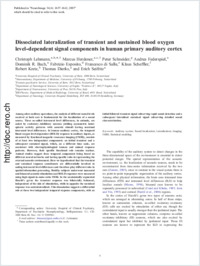Dissociated lateralization of transient and sustained blood oxygen level-dependent signal components in human primary auditory cortex
- Lehmann, Christoph University Hospital of Clinical Psychiatry, University of Bern, Switzerland - Neuroanatomy, Department of Medicine, University of Fribourg, Switzerland
- Herdener, Marcus University Hospital of Clinical Psychiatry, University of Bern, Switzerland - Forensic-psychiatric Service, University of Bern, Switzerland
- Schneider, Peter Department of Neurology, University Hospital Heidelberg, Germany
- Federspiel, Andrea University Hospital of Clinical Psychiatry, University of Bern, Switzerland
- Bach, Dominik R. University Hospital of Clinical Psychiatry, University of Bern, Switzerland
- Esposito, Fabrizio Department of Neurological Sciences, University of Naples “Federico II”, Italy
- di Salle, Francesco Department of Neuroscience, University of Pisa, Italy
- Scheffler, Klaus MR-Physics, Department of Medical Radiology, University of Basel, Switzerland
- Kretz, Robert Neuroanatomy, Department of Medicine, University of Fribourg, Switzerland
- Dierks, Thomas University Hospital of Clinical Psychiatry, University of Bern, Switzerland
- Seifritz, Erich University Hospital of Clinical Psychiatry, University of Bern, Switzerland
-
18.12.2006
Published in:
- NeuroImage. - 2007, vol. 34, no. 4, p. 1637-1642
English
Among other auditory operations, the analysis of different sound levels received at both ears is fundamental for the localization of a sound source. These so-called interaural level differences, in animals, are coded by excitatory–inhibitory neurons yielding asymmetric hemispheric activity patterns with acoustic stimuli having maximal interaural level differences. In human auditory cortex, the temporal blood oxygen level-dependent (BOLD) response to auditory inputs, as measured by functional magnetic resonance imaging (fMRI), consists of at least two independent components: an initial transient and a subsequent sustained signal, which, on a different time scale, are consistent with electrophysiological human and animal response patterns. However, their specific functional role remains unclear. Animal studies suggest these temporal components being based on different neural networks and having specific roles in representing the external acoustic environment. Here we hypothesized that the transient and sustained response constituents are differentially involved in coding interaural level differences and therefore play different roles in spatial information processing. Healthy subjects underwent monaural and binaural acoustic stimulation and BOLD responses were measured using high signal-to-noise-ratio fMRI. In the anatomically segmented Heschl’s gyrus the transient response was bilaterally balanced, independent of the side of stimulation, while in opposite the sustained response was contralateralized. This dissociation suggests a differential role at these two independent temporal response components, with an initial bilateral transient signal subserving rapid sound detection and a subsequent lateralized sustained signal subserving detailed sound characterization.
- Faculty
- Faculté des sciences et de médecine
- Department
- Département de Médecine
- Language
-
- English
- Classification
- Biological sciences
- License
-
License undefined
- Identifiers
-
- RERO DOC 9281
- DOI 10.1016/j.neuroimage.2006.11.011
- Persistent URL
- https://folia.unifr.ch/unifr/documents/300765
Statistics
Document views: 149
File downloads:
- pdf: 235
